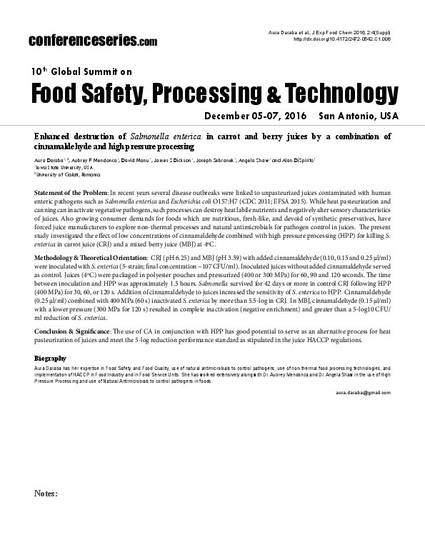
Statement of the Problem: In recent years several disease outbreaks were linked to unpasteurized juices contaminated with human enteric pathogens such as Salmonella enterica and Escherichia coli O157:H7 (CDC 2011; EFSA 2015). While heat pasteurization and canning can inactivate vegetative pathogens, such processes can destroy heat labile nutrients and negatively alter sensory characteristics of juices. Also growing consumer demands for foods which are nutritious, fresh-like, and devoid of synthetic preservatives, have forced juice manufacturers to explore non-thermal processes and natural antimicrobials for pathogen control in juices. The present study investigated the effect of low concentrations of cinnamaldehyde combined with high pressure processing (HPP) for killing S. enterica in carrot juice (CRJ) and a mixed berry juice (MBJ) at 4ºC. Methodology & Theoretical Orientation: CRJ (pH 6.25) and MBJ (pH 3.59) with added cinnamaldehyde (0.10, 0.15 and 0.25 μl/ml) were inoculated with S. enterica (5-strain; final concentration ~107 CFU/ml). Inoculated juices without added cinnamaldehyde served as control. Juices (4ºC) were packaged in polyester pouches and pressurized (400 or 300 MPa) for 60, 90 and 120 seconds. The time between inoculation and HPP was approximately 1.5 hours. Salmonella survived for 42 days or more in control CRJ following HPP (400 MPa) for 30, 60, or 120 s. Addition of cinnamaldehyde to juices increased the sensitivity of S. enterica to HPP. Cinnamaldehyde (0.25 μl/ml) combined with 400 MPa (60 s) inactivated S. enterica by more than 5.5-log in CRJ. In MBJ, cinnamaldehyde (0.15 μl/ml) with a lower pressure (300 MPa for 120 s) resulted in complete inactivation (negative enrichment) and greater than a 5-log10 CFU/ ml reduction of S. enterica. Conclusion & Significance: The use of CA in conjunction with HPP has good potential to serve as an alternative process for heat pasteurization of juices and meet the 5-log reduction performance standard as stipulated in the juice HACCP regulations.
Available at: http://works.bepress.com/angela_shaw/23/

This abstract is published as Daraba[SLL[1] , A., Mendonca, A., Manu, D., Dickson, J., Sebranek, J., Shaw, A., and A. Dispirito. 2016. Enhanced destruction of Salmonella enterica in carrot and berry juices by a combination of cinnamaldehyde and high pressure processing. Journal of Experimental Food Chemistry: 2:4 (supplement). DOI: 10.4172/2472-0542.C1.006.